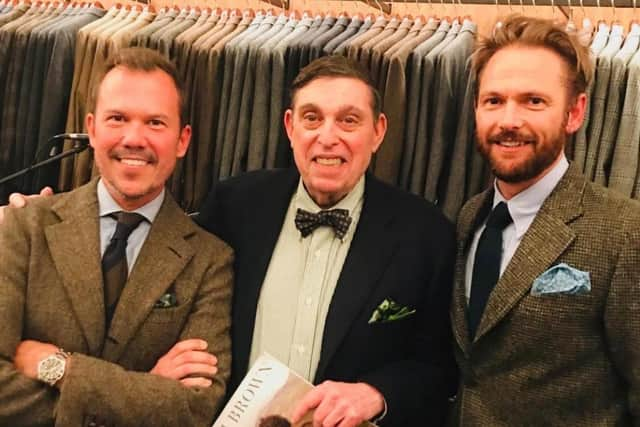An American Dream tale wrapped in Harris Tweed


Ivy Style and Harris Tweed belong in the same sentence. In the post-war decades when vast quantities of the fabric were bound for the United States, it was to feed a market in which the Harris Tweed blazer had become an essential part of the well-dressed American male’s wardrobe – Ivy Style.
The fashion was driven by a small number of companies which became hugely influential in defining American dress sense and had grown up around the Ivy League campuses. The New England campuses of Harvard, Yale, Princeton and Richard Press’s own alma mater, Dartmouth, were all old stone buildings mostly set in cold, damp forests – so the versatility and warmth of Harris Tweed came to the fore.
Advertisement
Hide AdAdvertisement
Hide AdThis book covers the heritage of one of the Ivy Style companies. The story is told by the charismatic grandson of its founder Jacobi Press, who emigrated to the US in 1896 and went on to found a fashion brand integral to the Ivy League look and the success of Harris Tweed in the USA.
Richard Press is a natural raconteur and this is not just a story of fashion. It runs deeper. Leaving an impoverished Shtetl in modern day Latvia, Jacobi Press escaped a life of enforced religion and an even worse fate that would come with the pogroms a mere 45 years later of the Nazi murder machine.
Richard Press tells the story of his grandfather Jacobi joining his brothers in Boston, learning the skills of tailoring and business from the wider Jewish community. The first J. Press store opened in New Haven, Connecticut in 1902. Within a decade he was heading back across the Atlantic to buy premier British fabrics including Harris Tweed.
The stories are rich in variety with a nice balance of Press’s time at Dartmouth college and his move through the ranks of the family business, rising from the shop floor to heading up the business by the mid-70s.
Advertisement
Hide AdAdvertisement
Hide AdThe majority of the narrative comes after World War II when the Cold War was hotting up and the Ivy League look of flannels, Oxford button-down shirt and Harris Tweed jacket was spreading far beyond the privileged few.
President Roosevelt’s 1944 G.I. Bill of Rights expanded access to the Ivy League and other good universities across the US and J. Press were fast to adapt to the demand in off-the-peg clothing.
Khaki and Madras may have come into the Preppy wardrobe but the desire for Shetland jumpers and tweed jackets stayed true as the heyday of Ivy Style unfolded in the middle decades of what many historians now call the American Century.
The book is peppered with tales of the celebrity guests that frequented the New York store. Press (an off-Broadway amateur thespian himself) excels in the retelling of wild nights out with Frank Sinatra. “Unfortunately for future Sinatra historians, my memory of the early morning at the storied saloon is hazy at best and becomes more of a drunken blur as the evening wore on. As Toots Shor himself often said, ‘a bum who ain’t drunk by midnight ain’t trying’ and this bum had been drunk since well before midnight”
Advertisement
Hide AdAdvertisement
Hide AdThe encounters meander from Hollywood A-listers like Cary Grant to brief encounters with Ernest Hemingway and more profound relationships with broadcaster Walter Cronkite and the advertising guru David Ogilvie. The encounters with Ogilvie are a stand-out with Irving Press (Richard’s uncle) subtly trying to get the great man’s opinion on J. Press’s marketing brochure; “Mr Press, you don’t need my input. Just keep doing what you’re doing so well.”
There is insight into product development too – J. Press were at the vanguard of the transition from formal menswear to off-the-peg jackets and coats – they did classic clothing but always with an injection of flair in colour and cut that differentiated their look from competitors.
Their unique Shetland sweaters are a particularly good example ever since a travelling Scottish salesman advised: “Brush ‘em until she feels like a shaggy dog”. The company trademarked Shaggy Dog and the jumpers continue to sell in an array of beautiful colours season after season.
There is a warm affection for Harris Tweed throughout. The tailoring traditions of J. Press permeate the brand ethos for quality and detail and where others opted for cheaper synthetic fabrics, Jacobi believed in authenticity. “The Harris Tweed jacket still retained the faint aroma of peat from the smoke room in The Outer Hebrides”
Advertisement
Hide AdAdvertisement
Hide AdThreading the Needle gives the inside story of J. Press and the heyday of Ivy Style but is also a story of a Jewish immigrant building a company that was instrumental in the Ivy Style look. It is about achieving the American Dream within a generation of arriving at Boston harbour and a demonstration that if you work hard, the rewards are high.
Richard Press sums up the journey: “My grandfather’s family’s rabbinical tradition died in the shtetl when he came to America, but the taste and style he and his sons promoted in the 20th century are today brought forth by a dedicated team that took over the family business nearly a third of a century ago. As the surviving family member still on the playing field, I bear witness to the ongoing foundation traditions, still banging the drum slowly.”
And still banging it, I’m pleased to say, for Harris Tweed.
Mark Hogarth is creative director of Harris Tweed Hebrides